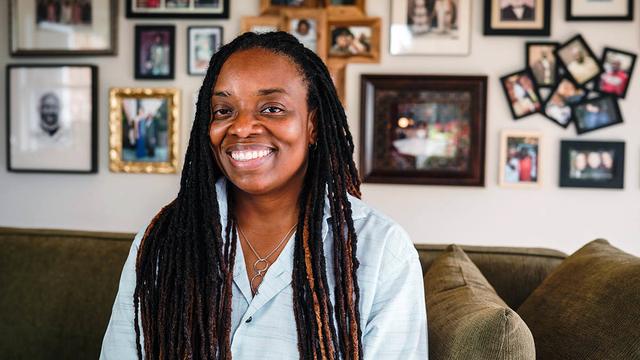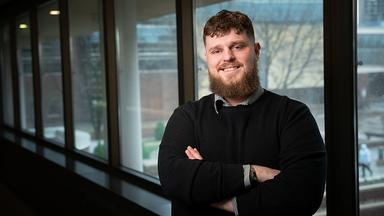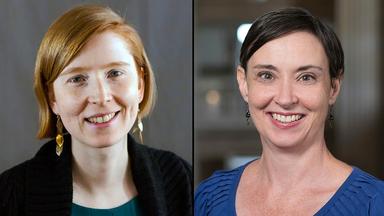As cities and counties continue to grow in variations of age, economic status, educational attainment, immigration levels, and population size, they find themselves in need of someone who can focus on identifying disparities in community programs and services and on helping create ways for departments to address those gaps.
Enter the chief equity officer. No matter the exact job title, they will be crucial in leading the charge for equity and inclusivity.
Humphrey School alumna Tyeastia Green (MPA ’19) recently took on that role in Burlington, Vermont; in March, she was hired as that city’s first director of racial equity, inclusion, and belonging. With a population of about 43,000, Burlington is the largest city in Vermont. It is 85 percent white, 5 percent Black or African American, and 6 percent Asian.
Green earned her bachelor’s degree in information technology in 2006, and held a variety of computer support positions before turning to racial equity and inclusion work for the city of Bloomington.
Green says she was inspired to apply to the Humphrey School in 2016 when she heard Barack Obama’s farewell speech as he completed his term as president. “He said, ‘I am asking you to believe. Not in my ability to bring about change – but in yours.’ President Obama did more than inspire me,” Green says. “He helped wake up the leader that was there all along.”
Green continued working for the city of Bloomington while completing her Master of Public Affairs, which is designed for mid-career students. She tailored her degree to focus on Antiracism/Racial Social Justice and Public Policy. Less than a year after graduation, she landed in Vermont.
We asked Green to reflect on her time at the Humphrey School and her experience establishing an equity and inclusion presence in Burlington. Her responses have been edited for length and clarity.
What was the best part of the Humphrey School’s MPA program for you?
The best part of the MPA program is the cohort style of learning. You’re in a class with people who have lived a life outside of school; who have careers, and are a bit older than the average student. Spending an entire year, one weekend a month, with your cohort builds a bond that I never had in undergrad. You get to know your fellow students on a personal level. The conversations held during class discussions were deep and encouraged vulnerability. Being the TA in the program during my second year was great for honing my leadership skills, understanding curriculum creation, and building lasting relationships.
How did your coursework prepare you for your current position?
At Humphrey, it is hard to find graduate level courses on race, racialization, antiracism, whiteness, etc. Dr. Samuel Myers Jr. is the only professor that had courses related to race in a meaningful way. In the other courses I took I brought that racial lens with me, because the curriculum did not give a nod to the most nuanced issue we have in public policy. I am hopeful Humphrey will change that. Racial justice should be a degree option, and classes on race as a social construct should be mandatory. Humphrey is building policy leaders, and it’s imperative that those leaders have a foundational understanding of race.
What are your impressions of Burlington?
Burlington is a very different place [than Minneapolis]. It’s small, quaint, and white. I’m still not over the culture shock of being in a place where I have to struggle to find people who look like me, and that has a population that could fill only half of the US Bank Stadium.
Nevertheless, I have met so many people who are eager to help me succeed, and that feels amazing. I do feel that Burlington is ready for change, ready for racial justice. I moved here on March 16, the day before the city shut down for two months [due to the pandemic]. I cannot judge my experience here yet because that wouldn’t be fair. I haven’t been able to experience the liveliness, the events Burlington is famous for, and the community that I hear so much about. But I can say, because of the overdue racial reckoning and awakening the country is engaged in, what an inspiring time it is to be here doing this work, and for that I’m grateful.
What does your role as director of racial equity, inclusion, and belonging entail?
My job currently focuses on race-centered policy creation and implementation, a reparations study for Vermont’s role in chattel slavery (that I’m happy Humphrey’s Rashad Williams will be a part of), creating antiracist curriculum for 1,000+ city employees and city council, engaging in work surrounding racism as a public health emergency, implementing police transformation, and ensuring a racially just recovery from COVID-19. My long-term focus is on changing and challenging practices and policies that harm BIPOC (Black, Indigenous, and People of Color). It is important to me that I fully utilize this role to ensure that Burlington will be on the right side of history moving forward.
What is one of the biggest challenges in your community, and how does it intersect with systemic racism?
It is important to frame racism as what it is—a system, not an event. I believe the challenges of racism in all forms affect each community the same. Regardless of whether you live in the north or south, on either of the coasts or in the heartland, racism in its structural, institutional, and systemic form doesn’t change. Racism is in education, healthcare, income, wealth attainment, housing, childcare, banking, and on and on. It’s everywhere. It’s what we eat, drink, and breathe. It’s pervasive and normalized. When I think of the challenge of undoing systemic racism, I have the image of a ball of rubber bands. Once you think you’ve got the hang of unraveling it, you realize there’s so much going on underneath, and some of the rubber bands feel impossible to remove.
How do you engage with the leadership of your city to support your efforts?
Every day I come to work as my authentic self. It is my job to point out instances when whiteness is centered; it is also my job to keep BIPOC in the forefront of our minds when we are making decisions that will undoubtedly affect them, and all too often leave them out. I am here to ensure that BIPOC aren’t left out. I am here to ensure that the city works toward achieving racial equity. Early on in my tenure I engaged the mayor on declaring racism a public health emergency. We were able to do that together with the help of the Vermont Racial Justice Alliance and many organizations throughout the city. In the FY21 budget, the mayor of Burlington, Miro Weinberger, dedicated $1 million to the fight against systemic racism.
What are the best methods for engaging with people who are reluctant, afraid, or uncomfortable with having these discussions?
I’ve always believed the best method to speak up in any room is with honesty. No smoke and mirrors, just pure honesty. It’s important to show up as who you are—authentic, with your life story and the way you see the world. Affinity groups are a great option for having discussions with people who see the world as you do. They provide the safe space that people need to really dig deep in these conversations. When you’re in a safe space, it removes the requirement to be brave.
During affinity group meetings, racial awakening occurs. It is when whites realize that they too have a race, have been racialized, and that their race has meaning. For BIPOC communities, affinity groups can provide guidance on how to navigate white spaces, how to share methods of resiliency, and how to work toward accomplishing self-care. It is not the oppressed communities who should be tasked with fixing racism. That work falls solely on those who are a part of the dominant group. Racial awakening is an important step of that work and at the core of dismantling systemic racism.
What should local governments do to create an equitable and inclusive environment?
My advice would be to focus on race-centered policies. There’s too much focus on race-neutral policies because that’s what is deemed to be politically correct. I believe one of the biggest barriers we have to becoming inclusive is political correctness—to not upset the status quo, and not disrupt normalcy. The standard of normalcy in our society is whiteness. When we use terms like diversity, a question you should ask yourself is, ‘Diverse from what?’ And the answer that will appear is, ‘Different from whiteness.’ The term diversity keeps white supremacy culture alive by ‘othering’ populations who are not white. Don’t ask, ‘How do I attract diverse talent?’ or ‘How can I increase diversity in my organization?’ Instead, ask what it means to be inclusive of other races, cultures, and perspectives. It is not about seeking answers externally. It’s about looking inward by performing organizational analysis, and receiving the answers to make significant changes.
Adapted from an article in PM (Public Management) Magazine, published by ICMA – the International City/County Management Association.


